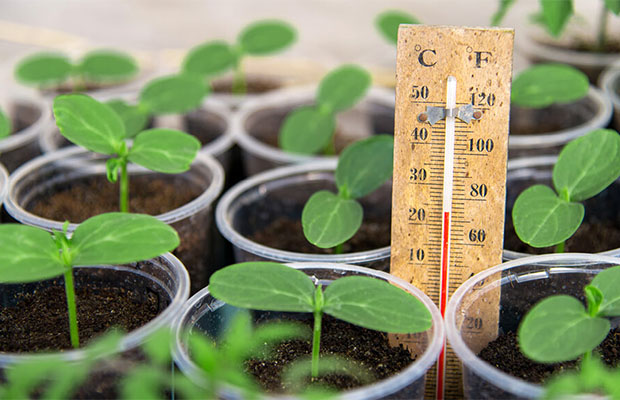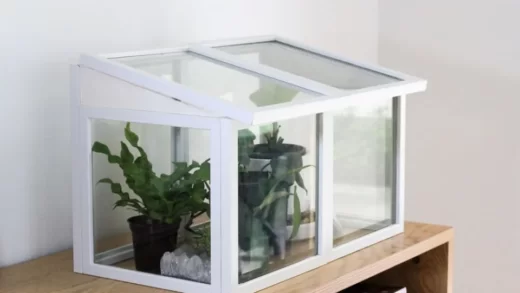As winter approaches and brings a drop in temperature, it’s vital to think about heating a grow room to keep your plants happy and healthy.
When cold air seeps through every crack and crevice, it can be difficult to keep your leafy friends warm. No matter if your grow room is set up in a greenhouse, outdoor hoop house, or your basement.
Here are some methods to make sure your plants are at their best when winter does arrive. Let’s start!
You May Also Like: Grow Room Ventilation Setup
Table of Contents
Tips To Heat A Grow Room
Monitor Temperature
Plants thrive in temperatures between 25-28°C during lights on, and around 18-21°C whilst lights are off, so it is important to check your temperatures regularly to ensure these conditions are consistently being hit. Using a Digital Thermometer is the best way to identify if something needs addressing to reach the optimum temperature.

Soil Heating Mats
Focusing on heating the soil rather than the air is one of the first options available for heating your grow room. Under your trays and pots, soil or seedling mats provide the warmth that growing plants require. When you want the ideal soil temperature of between 75 and 85 degrees Fahrenheit but can’t bear the thought of trying to maintain the heat in your house or greenhouse at that level, these soil mats are a fantastic alternative. This mat is useful for heating plants that have already germinated, but some people only consider it to be a germination mat.
Heat Lamps
Heat lamps are another choice, but based on your setup, they might not be the best option. Instead of heated soil mats, some people may choose heat lamps, but this decision can occasionally backfire. The heat lamp may cause burns to your foliage and dry out your plants, depending on where it is placed in your setup and how long it is left on. When using a heat lamp, you should only leave it on for a brief period of time, and you should always check the soil’s moisture content. You probably will need to water frequently to keep the dirt moist.
Compost Generated Heat
You can use compost to warm your plants, despite what might seem crazy. This approach is a great one for greenhouses and hoop houses because it allows for the creation of a heat sink. To make it unproblematic, you can dig a trench inside your greenhouse and cover it with a kind of detachable walkway.
Thanks to your warm daytime temperatures, this compost will heat up and release its heat later in the day. Furthermore, you will have all of that black gold available to add to your garden as an added benefit. Just bear in mind that you’ll need to carefully consider where you’re going to put that mostly open compost pile.
Water Storage
Keeping water in the vicinity of your greenhouse or hoop house is another way to act as a heat sink. The location of the water storage should be such that it can receive daytime solar heating. The heat energy will then be released into the surrounding area during the night as the water cools.
The advantage of having water available for your garden with this option is that you can siphon it off, but you must make sure to add the water back in. You can no longer store heat in the water, so you must remove it.
You can use any water storage containers you have on hand, but a 55-gallon barrel makes a good starting point. Use dark materials for your tanks to aid in maximizing heat absorption.
Related Reading: Grow Room Watering System
Add A Fan Heater
Warm air can be blown directly onto your plants by a fan heater, an additional heating appliance. If you live in a very cold climate and find it difficult to maintain a warm environment in your grow room, this can be a useful addition. If your air is dry, however, fan heaters may harm a plant. To ensure that your humidity levels are suitable for your plants, it is advisable to work with a commercial HVAC repair and service company. If your relative humidity is low, they might advise installing a humidifier in addition to the fan heater.
Electric Room Heaters
Electric room heaters are a common choice. While some horticultural options use standard room heaters, others are specifically designed for greenhouse heating. This type of heater necessitates the use of an extension cord or of electrical outlets in the room where the heater will be placed. Remember that you must use these heaters properly; you don’t want to start a fire because your heater was too close to flammable substances.
Nutrient Care
It is crucial that the temperature be maintained between 18 and 21 degrees Celsius when mixing nutrient solutions, especially when doing so in larger quantities and storing them in a water tank for several days. The roots of the plants will go into shock at too low a temperature, which will slow uptake and impede growth. In contrast, if it is too warm, the oxygen levels will drop, plant growth will slow down once more, and the plants will be more vulnerable to diseases like Pythium, also known as Root Rot.
The use of a Water Heater is necessary to avoid this problem and maintain pre-mixed nutrient solutions at the ideal temperature. They float in the water tank and keep the solution constantly at the predetermined temperature due to their complete submersibility.
Effective nutrient storage is crucial because inadequate nutrient storage can cause nutrients to become contaminated. Your nutrients’ dissolved salts could solidify and crystallize if storage is kept at a temperature that is too low. They are no longer a component of the nutrient solution and are still inaccessible to your plants in this form.
Nutrients should be kept in dark, cool spaces that are out of direct sunlight and have temperatures between 10 and 19 °C in order to avoid this. As a rule, never allow your nutrients to be stored at temperatures below 5°C.
Growroom Circulation
When using any of these heat sources, one thing you should remember to do is to move the heated air around your room. Your greenhouse shouldn’t develop any hot or cold spots. Additionally, heating a space where you’re watering or hydroponically growing plants, helps prevent condensation from forming. Some heaters will come with a built-in circulation system, like a fan, but you must decide whether your setup calls for additional circulation.
Growroom Insulation
Despite being a passive heater, insulation can increase the effectiveness of your efforts. There are some circumstances where adding insulation may not be necessary, such as covering greenhouse windows because doing so would prevent sunlight from entering, but there are other instances where doing so can be beneficial. Gardeners who grow their plants in basements or other interior spaces may discover that simply adding insulation can significantly reduce the amount of heat loss and increase the amount of heat gain.
Depending on what you’re growing and how things are currently set up, you’ll need a certain temperature in your grow room. You can tailor your heating strategy to suit your needs once you know what temperature you should try to achieve. To achieve the ideal temperature in your grow room, you might need to combine some of these options.
The Bottom Line
Plants generally thrive in the 70s, regardless of the temperature outside. It may take weeks for plants to recover their growth rate after even a brief temperature change.
Therefore, keeping your grow room warm should be a top priority as winter continues. Have you met any problems when heating a grow room? Leave your comment!
Other Posts You Might Like: Best Water Temp For Growing Weed

















